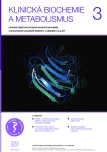Galectin-3: an overview, pathophysiology, analytics, limits of interpretation and biological variation.
Authors:
J. Franeková 1,2; A. Jabor 1,2
Authors‘ workplace:
Oddělení klinické biochemie, Pracoviště laboratorních metod, Institut klinické a experimentální medicíny, Praha
1; Ústav imunologie a klinické biochemie, 3. lékařská fakulta Univerzity Karlovy, Praha
2
Published in:
Klin. Biochem. Metab., 30, 2022, No. 3, p. 68-72
Overview
Galectin-3, a member of the family of soluble non-glycosylated lectins, is a newer biomarker with a prognostic role in heart, lung, kidney, liver, and other organ diseases. Galectin-3 has proinflammatory and profibrotic effects and is involved in the pathophysiology of the development of heart failure. An automated analytical method with robust analytical characteristics is available, and reference intervals and decision limits are known. There is a consensus in the cardiology literature for an increased risk of worse prognosis due to fibrosis and inflammation at galectin-3 concentrations above 18 μg/L. Biological variation is known both in healthy subjects and patients with heart diseases and galectin-3 concentrations are stable over time. Most data on galectin-3 available in the literature relate to cardiac disease diagnostics - it belongs among the biomarkers with possible use mainly in heart failure, myocardial infarction, and heart transplantation. Due to the planned reimbursement by health insurance companies and its diagnostic and prognostic potential, galectin-3 seems to be a biomarker suitable for use in routine clinical practice.
Keywords:
reference interval – decision limits – Galectin-3 – analytical characteristics – biological variation
Sources
1. Liu, Y., Meng, H., Xu, S., Qi, X. Galectins for diagnosis and prognostic assessment of human diseases: an overview of meta-analyses. Med. Sci. Monit., 2020, 26, e923901.
2. Sciacchitano, S., Lavra, L., Morgante, A., et al. Galectin-3: One molecule for an alphabet of diseases, from A to Z. Int. J. Mol. Sci., 2018, 19(2), 379.
3. Hara, A., Niwa, M., Kanayama, T., et al. Galectin-3: A potential prognostic and diagnostic marker for heart disease and detection of early stage pathology. Biomolecules, 2020, 10(9), 1277.
4. Ho, M. K., Springer, T. A. Mac-2, a novel 32,000 Mr mouse macrophage subpopulation-specific antigen defined by monoclonal antibodies. J. Immunol., 1982, 128(3), 1221-1228.
5. Ho, M. K., Springer, T. A. Tissue distribution, structural characterization, and biosynthesis of Mac-3, a macrophage surface glycoprotein exhibiting molecular weight heterogeneity. J Biol. Chem., 1983, 258(1), 636 - 642.
6. Dumic, J., Dabelic, S., Flögel, M. Galectin-3: an openended story. Biochim. Biophys, Acta, 2006, 1760(4), 616-635.
7. Suthahar, N., Meijers, W. C., Sillje, H. H. W., Ho, J. E., Liu, F. T., de Boer, R. A. Galectin-3 Activation and inhibition in heart failure and cardiovascular disease: An update. Theranostics, 2018, 8(3), 593 - 609.
8. Slack, R. J., Mills, R., Mackinnon, A. C. The therapeutic potential of galectin-3 inhibition in fibrotic disease. Int. J Biochem. Cell. Biol., 2021, 130, 105881.
9. Meijers, W. C., van der Velde, A. R., de Boer, R. A. The ARCHITECT galectin-3 assay: comparison with other automated and manual assays for the measurement of circulating galectin-3 levels in heart failure. Expert Rev. Mol. Diagn., 2014, 14, 257-266.
10. Gaze, D. C., Prante, C., Dreier, J., et al. Analytical evaluation of the automated galectin-3 assay on the Abbott ARCHITECT immunoassay instruments. Clin. Chem. Lab. Med., 2014, 52(6), 919-926.
11. Christenson, R. H., Duh, S. H., Wu, A. H., et al. Multicenter determination of galectin-3 assay performance characteristics: Anatomy of a novel assay for use in heart failure. Clin. Biochem., 2010, 43(7-8), 683-690.
12. McCullough, P. A., Olobatoke, A., Vanhecke, T. E. Galectin-3: a novel blood test for the evaluation and management of patients with heart failure. Rev Cardiovasc Med, 2011, 12(4), 200-210. Erratum in: Rev. Cardiovasc. Med., 2012, 13(1), e52.
13. McCullough, P. A. Practical experience using galectin-3 in heart failure. Clin. Chem. Lab. Med., 2014, 52(10), 1425-1431.
14. Krintus, M., Kozinski, M., Fabiszak, T., Kubica, J., Panteghini, M., Sypniewska, G. Establishing reference intervals for galectin-3 concentrations in serum requires careful consideration of its biological determinants. Clin. Biochem., 2017, 50(10-11), 599-604.
15. Wu, A. H., Wians, F., Jaffe, A. Biological variation of galectin-3 and soluble ST2 for chronic heart failure: implication on interpretation of test results. Am. Heart. J., 2013, 165(6), 995-999.
16. Meijers, W. C., van der Velde, A. R., Muller Kobold, A. C., et al. Variability of biomarkers in patients with chronic heart failure and healthy controls. Eur. J Heart. Fail., 2017, 19(3), 357-365.
17. Schindler, E. I., Szymanski, J. J., Hock, K. G., Geltman, E. M., Scott, M. G. Short - and long-term biologic variability of galectin-3 and other cardiac biomarkers in patients with stable heart failure and healthy adults. Clin. Chem., 2016, 62(2), 360-366.
18. Franeková, J., Kubíček, Z., Hošková, L., et al. Long-term biological variability of galectin-3 after heart transplantation. Clin. Chem. Lab. Med., 2015, 53(1), 119-123.
19. Meijers, W. C., Bayes-Genis, A., Mebazaa, A., et al. Circulating heart failure biomarkers beyond natriuretic peptides: review from the Biomarker Study Group of the Heart Failure Association (HFA), European Society of Cardiology (ESC). Eur. J Heart. Fail., 2021, 23(10), 1610 - 1632.
Labels
Clinical biochemistry Nuclear medicine Nutritive therapistArticle was published in
Clinical Biochemistry and Metabolism

2022 Issue 3
Most read in this issue
- MxA protein and its application in early diagnosis of viral infections including SARS-CoV-2
- How we can put patients´ lives at risk together
- Galectin-3: an overview, pathophysiology, analytics, limits of interpretation and biological variation.
- Biological variability. Concepts and literature recommended to education
